Modelling the Atmospheric Environment Associated with a Wind-Driven Fire Event in Portugal
Abstract
:1. Introduction
2. Study Area and Data Sources
2.1. Study Area
2.2. Data Sources
2.2.1. Meteorological Data
2.2.2. Numerical Modelling
3. Results
3.1. Overview of the Fire Event
3.2. Model Verification
3.3. Synoptic Environment
3.4. Mesoscale Environment and Fire Weather Conditions
4. Discussion
5. Conclusions
Author Contributions
Funding
Institutional Review Board Statement
Informed Consent Statement
Data Availability Statement
Acknowledgments
Conflicts of Interest
References
- Pereira, M.G.; Trigo, R.M.; da Camara, C.C.; Pereira, J.M.C.; Leite, S.M. Synoptic patterns associated with large summer forest fires in Portugal. Agric. For. Meteorol. 2006, 129, 11–25. [Google Scholar] [CrossRef]
- Amraoui, M.; Pereira, M.G.; DaCamara, C.C.; Calado, T.J. Atmospheric conditions associated with extreme fire activity in the Western Mediterranean region. Sci. Total Environ. 2015, 524–525, 32–39. [Google Scholar] [CrossRef]
- Werth, P.A. Critical Fire Weather Patterns. In Synthesis of Knowledge of Extreme Fire Behavior: Volume I for Fire Managers; United States Department of Agriculture Forest Service: Washington, DC, USA, 2011; pp. 25–48. [Google Scholar]
- Keeley, J.E.; Syphard, A.D. Twenty-first century California, USA, wildfires: Fuel-dominated vs. wind-dominated fires. Fire Ecol. 2019, 15, 24. [Google Scholar] [CrossRef] [Green Version]
- Whiteman, C.D. Fire Weather and Smoke Management. In Mountain Meteorology: Fundamentals and Applications, 21st ed.; Oxford University Press: New York, NY, USA, 2000; pp. 237–272. [Google Scholar]
- Clements, C.B.; Seto, D. Observations of Fire–Atmosphere Interactions and Near-Surface Heat Transport on a Slope. Bound.-Layer Meteorol. 2015, 154, 409–426. [Google Scholar] [CrossRef]
- Vanella, M.; McGrattan, K.; McDermott, R.; Forney, G.; Mell, W.; Gissi, E.; Fiorucci, P. A Multi-Fidelity Framework for wildland Fire Behavior Simulations over Complex Terrain. Atmosphere 2021, 12, 273. [Google Scholar] [CrossRef]
- McCarthy, E.F. Forest fires and storm movement. Mon. Weather Rev. 1924, 52, 257–259. [Google Scholar] [CrossRef]
- Byram, G.M. Atmospheric Conditions Related to Blow-Up Fires; Station Paper SE-SP-35; USDA-Forest Service, South-Eastern Forest Experiment Station: Asheville, NC, USA, 1954; 36p.
- Sharples, J. Review of formal methodologies for wind-slope correction of wildfire rate of spread. Int. J. Wildland Fire 2008, 17, 179–193. [Google Scholar] [CrossRef]
- Brewer, M.J.; Clements, C.B. The 2018 Camp Fire: Meteorological Analysis Using In Situ Observations and Numerical Simulations. Atmosphere 2020, 11, 47. [Google Scholar] [CrossRef] [Green Version]
- Moritz, M.A.; Moody, T.J.; Krawchuk, M.A.; Hughes, M.; Hall, A. Spatial variation in extreme winds predicts large wildfire locations in chaparral ecosystems. Geophys. Res. Lett. 2010, 37, L04801. [Google Scholar] [CrossRef] [Green Version]
- Jin, Y.; Randerson, J.T.; Capps, S.; Hall, A.; Faivre, N.; Goulden, M.L. Contrasting controls on wildland fires in Southern California during periods with and without Santa Ana events. J. Geophys. Res. Biogeosci. 2014, 119, 432–450. [Google Scholar] [CrossRef] [Green Version]
- Ruffault, J.; Moron, V.; Trigo, R.M.; Curta, T. Daily synoptic conditions associated with large fire occurrence in Mediterranean France: Evidence for a wind-driven fire regime. Int. J. Clim. 2017, 37, 524–533. [Google Scholar] [CrossRef]
- Lagouvardos, K.; Kotroni, V.; Giannaros, T.M.; Dafis, S. Meteorological Conditions Conducive to the Rapid Spread of the Deadly Wildfire in Eastern Attica, Greece. Bull. Am. Meteorol. Soc. 2019, 100, 2137–2145. [Google Scholar] [CrossRef]
- Kartsios, S.; Karacostas, T.; Pytharoulis, I.; Dimitrakopoulos, A.P. Numerical investigation of atmosphere-fire interactions during high-impact wildland fire events in Greece. Atmos. Res. 2020, 247, 105253. [Google Scholar] [CrossRef]
- Hoinka, K.P.; Gaertner, M.; Castro, M. Iberian thermal lows in a changed climate. Q. J. R. Meteorol. Soc. 2007, 133, 1113–1126. [Google Scholar] [CrossRef] [Green Version]
- Salgado, R.; Miranda, P.M.A.; Lacarrère, P.; Noilhan, J. Boundary layer development and summer circulation in Southern Portugal. Tethys 2015, 12, 33–44. [Google Scholar] [CrossRef] [Green Version]
- Nauslar, N.J.; Abatzoglou, J.T.; Marsh, P.T. The 2017 North Bay and Southern California Fires: A Case Study. Fire 2018, 1, 18. [Google Scholar] [CrossRef] [Green Version]
- Couto, F.T.; Salgado, R.; Guiomar, N. Forest Fires in Madeira Island and the Fire Weather Created by Orographic Effects. Atmosphere 2021, 12, 827. [Google Scholar] [CrossRef]
- Potter, B.E. Column/Plume Dynamics. In Synthesis of Knowledge of Extreme Fire Behaviour: Vol I for Fire Managers; U.S. Department of Agriculture, Forest Service, Pacific Northwest Research Station: Corvallis, OR, USA, 2011; pp. 73–80. [Google Scholar]
- Kochanski, A.K.; Jenkins, M.A.; Mandel, J.; Beezley, J.D.; Krueger, S.K. Real time simulation of 2007 Santa Ana fires. For. Ecol. Manag. 2013, 294, 136–149. [Google Scholar] [CrossRef] [Green Version]
- Bova, A.; Mell, W.; Hoffman, C. A comparison of level set and marker methods for the simulation of wildland fire front propagation. Int. J. Wildland Fire 2015, 25, 229–241. [Google Scholar] [CrossRef]
- Bakhshaii, A.; Johnson, E. A review of a new generation of wildfire−atmosphere modeling. Can. J. For. Res. 2019, 49, 565–574. [Google Scholar] [CrossRef] [Green Version]
- Parente, J.; Pereira, M.G.; Amraoui, M.; Tedim, F. Negligent and intentional fires in Portugal: Spatial distribution characterization. Sci. Total Environ. 2018, 624, 424–437. [Google Scholar] [CrossRef] [Green Version]
- Trigo, R.; Pereira, J.; Pereira, M.; Mota, B.; Calado, T.; Camara, C.D.; Santo, F. Atmospheric conditions associated with the exceptional fire season of 2003 in Portugal. Int. J. Clim. 2006, 26, 1741–1758. [Google Scholar] [CrossRef]
- Pereira, M.G.; Malamud, B.D.; Trigo, R.M.; Alves, P.I. The history and characteristics of the 1980–2005 Portuguese rural fire database. Nat. Hazards Earth Syst. Sci. 2011, 11, 3343–3358. [Google Scholar] [CrossRef]
- Couto, F.T.; Iakunin, M.; Salgado, R.; Pinto, P.; Viegas, T.; Pinty, J.-P. Lightning modelling for the research of forest fire ignition in Portugal. Atmos. Res. 2020, 242, 104993. [Google Scholar] [CrossRef]
- Carmo, M.; Ferreira, J.; Mendes, M.; Silva, Á.; Silva, P.; Alves, D.; Reis, L.; Novo, I.; Xavier Viegas, D. The climatology of extreme wildfires in Portugal, 1980–2018: Contributions to forecasting and preparedness. Int. J. Clim. 2021, 42, 3123–3146. [Google Scholar] [CrossRef]
- Turco, M.; Jerez, S.; Augusto, S.; Tarín-Carrasco, P.; Ratola, N.; Jiménez-Guerrero, P.; Trigo, R.M. Climate drivers of the 2017 devastating fires in Portugal. Sci. Rep. 2019, 9, 13886. [Google Scholar] [CrossRef]
- Pinto, P.; Silva, Á.P.; Viegas, D.X.; Almeida, M.; Raposo, J.; Ribeiro, L.M. Influence of Convectively Driven Flows in the Course of a Large Fire in Portugal: The Case of Pedrógão Grande. Atmosphere 2022, 13, 414. [Google Scholar] [CrossRef]
- Trigo, R.M.; García-Herrera, R.; Díaz, J.; Trigo, I.F.; Valente, M.A. How exceptional was the early August 2003 heatwave in France? Geophys. Res. Lett. 2005, 32, L10701. [Google Scholar] [CrossRef] [Green Version]
- Rego, F.; Fernandes, P.; Silva, J.S.; Azevedo, J.C.; Moura, J.M.; Oliveira, E.; Cortes, R.; Viegas, D.X.; Caldeira, D.; Duarte Santos, F. Relatório de Avaliação do Incêndio de Fundada (Vila de Rei—Mação); Observatório Técnico Independente, Assembleia da República, Lisboa. 2020. Available online: https://www.parlamento.pt/Documents/2020/fevereiro/FINAL-Relatorio-de-Vila-de-Rei.pdf (accessed on 6 September 2021).
- Salgueiro, V.; Costa, M.J.; Guerrero-Rascado, J.I.; Couto, F.T.; Bortoli, D. Characterization of forest fire and Saharan desert dust aerosols over south-western Europe using a multi-wavelength Raman LIDAR and Sun-photometer. Atmos. Environ. 2021, 252, 118346. [Google Scholar] [CrossRef]
- Filippi, J.-B.; Bosseur, F.; Mari, C.; Lac, C. Simulation of a Large Wildfire in a Coupled Fire-Atmosphere Model. Atmosphere 2018, 9, 218. [Google Scholar] [CrossRef] [Green Version]
- Weather Spark—Condições Meteorológicas no Verão em Vila de Rei. Available online: https://pt.weatherspark.com/s/32215/1/Condi%C3%A7%C3%B5es-meteorol%C3%B3gicas-m%C3%A9dias-no-ver%C3%A3o-em-Vila-de-Rei-Portugal#Figures-WindDirection (accessed on 6 December 2021).
- Lourenço, L. Tipos de tempo correspondentes aos grandes incêndios florestais ocorridos em 1986 no centro de Portugal. Finisterra 1988, 46, 251–270. [Google Scholar] [CrossRef] [Green Version]
- Ferreira-Leite, F.; Bento-Gonçalves, A.; Lourenço, L. Grandes incêndios florestais em Portugal Continental. Da história recente à atualidade. Cadernos de Geografia 2012, 30–31, 81–86. [Google Scholar] [CrossRef] [Green Version]
- Ferreira-Leite, F.; Lourenço, L.; Bento-Gonçalves, A. Large forest fires in mainland Portugal, brief characterization. Mediterranee 2013, 121, 53. [Google Scholar] [CrossRef]
- Alexander, M.E.; Thorburn, W.R. Chapter 4—LACES: Adding an “A” for Anchor point(s) to the LCES wildland firefighter safety system. In Current International Perspectives on Wildland Fires, Mankind and the Environment, 1st ed.; Leblon, B., Alexander, M.E., Eds.; Nova Science Publishers: Hauppauge, NY, USA, 2015; pp. 121–144. [Google Scholar]
- Fernandes, A. Diretiva Operacional Nacional No. 2—DECIR: Dispositivo Especial de Combate a Incêndios Rurais 2021. Autoridade Nacional da Emergência e Proteção Civil. 2021. Available online: http://www.prociv.pt/bk/PROTECAOCIVIL/LEGISLACAONORMATIVOS/OUTROSNORMATIVOSDIRETIVAS/Documents/DON_2_DECIR_2021.pdf (accessed on 11 May 2022).
- Lac, C.; Chaboureau, J.-P.; Masson, V.; Pinty, J.-P.; Tulet, P.; Escobar, J.; Leriche, M.; Barthe, C.; Aouizerats, B.; Augros, C.; et al. Overview of the Meso-NH model version 5.4 and its applications. Geosci. Model Dev. 2018, 11, 1929–1969. [Google Scholar] [CrossRef] [Green Version]
- Champeaux, J.L.; Masson, V.; Chauvin, F. ECOCLIMAP: A global database of land surface parameters at 1 km resolution. Meteorol. Appl. 2005, 12, 29–32. [Google Scholar] [CrossRef]
- Cuxart, J.; Bougeault, P.; Redelsperger, J.L. A turbulence scheme allowing for mesoscale and large-eddy simulations. Q. J. R. Meteorol. Soc. 2000, 126, 1–30. [Google Scholar] [CrossRef]
- Verrelle, A.; Ricard, D.; Lac, C. Sensitivity of high-resolution idealized simulations of thunderstorms to horizontal resolution and turbulence parametrization. Q. J. R. Meteorol. Soc. 2015, 141, 433–448. [Google Scholar] [CrossRef]
- Pergaud, J.; Masson, V.; Malardel, S.; Couvreux, F. A parameterization of dry thermals and shallow cumuli for mesoscale numerical weather prediction. Bound.-Layer Meteorol. 2009, 132, 83–106. [Google Scholar] [CrossRef]
- Pinty, J.-P.; Jabouille, P. A mixed-phase cloud parameterization for use in mesoscale non-hydrostatic model: Simulations of a squall line and of orographic precipitations. In Proceedings of the Conference on Cloud Physics, Everett, WA, USA, 17–21 August 1998; American Meteorological Society: Boston, MA, USA, 1999; pp. 217–220. [Google Scholar]
- Masson, V.; Le Moigne, P.; Martin, E.; Faroux, S.; Alias, A.; Alkama, R.; Belamari, S.; Barbu, A.; Boone, A.; Bouyssel, F.; et al. The SURFEXv7.2 land and ocean surface platform for coupled or offline simulation of earth surface variables and fluxes. Geosci. Model Dev. 2013, 6, 929–960. [Google Scholar] [CrossRef] [Green Version]
- Anderson, H.E. Aids to Determining Fuel Models for Estimating fire Behaviour; Gen. Tech. Rep. INT-122; U.S. Department of Agriculture, Forest Service, Intermountain Forest and Range Experiment Station: Ogden, UT, USA, 1982.
- Soares, P.M.M.; Cardoso, R.M.; Semedo, Á.; Chinita, M.J.; Ranjha, R. Climatology of the Iberia coastal low-level wind jet: Weather research forecasting model high-resolution results. Tellus A 2014, 66, 22377. [Google Scholar] [CrossRef] [Green Version]
- Lima, D.C.A.; Soares, P.M.M.; Nogueira, M.; Semedo, A. Global coastal low-level wind jets revisited through the new ERA5 reanalysis. Int. J. Clim. 2021, 42, 4491–4507. [Google Scholar] [CrossRef]
- Trigo, R.M.; Sousa, P.M.; Pereira, M.G.; Rasilla, D.; Gouveia, C.M. Modelling wildfire activity in Iberia with different atmospheric circulation weather types. Int. J. Clim. 2016, 36, 2761–2778. [Google Scholar] [CrossRef]
- Peace, M.; Mattner, T.; Mills, G.; Kepert, J.; McCaw, L. Coupled Fire–Atmosphere Simulations of the Rocky River Fire Using WRF-SFIRE. J. Appl. Meteorol. Clim. 2016, 55, 1151–1168. [Google Scholar] [CrossRef]
- Ghaderi, M.; Ghodrat, M.; Sharples, J.J. LES Simulation of Wind-Driven Wildfire Interaction with Idealized Structures in the Wildland-Urban Interface. Atmosphere 2021, 12, 21. [Google Scholar] [CrossRef]
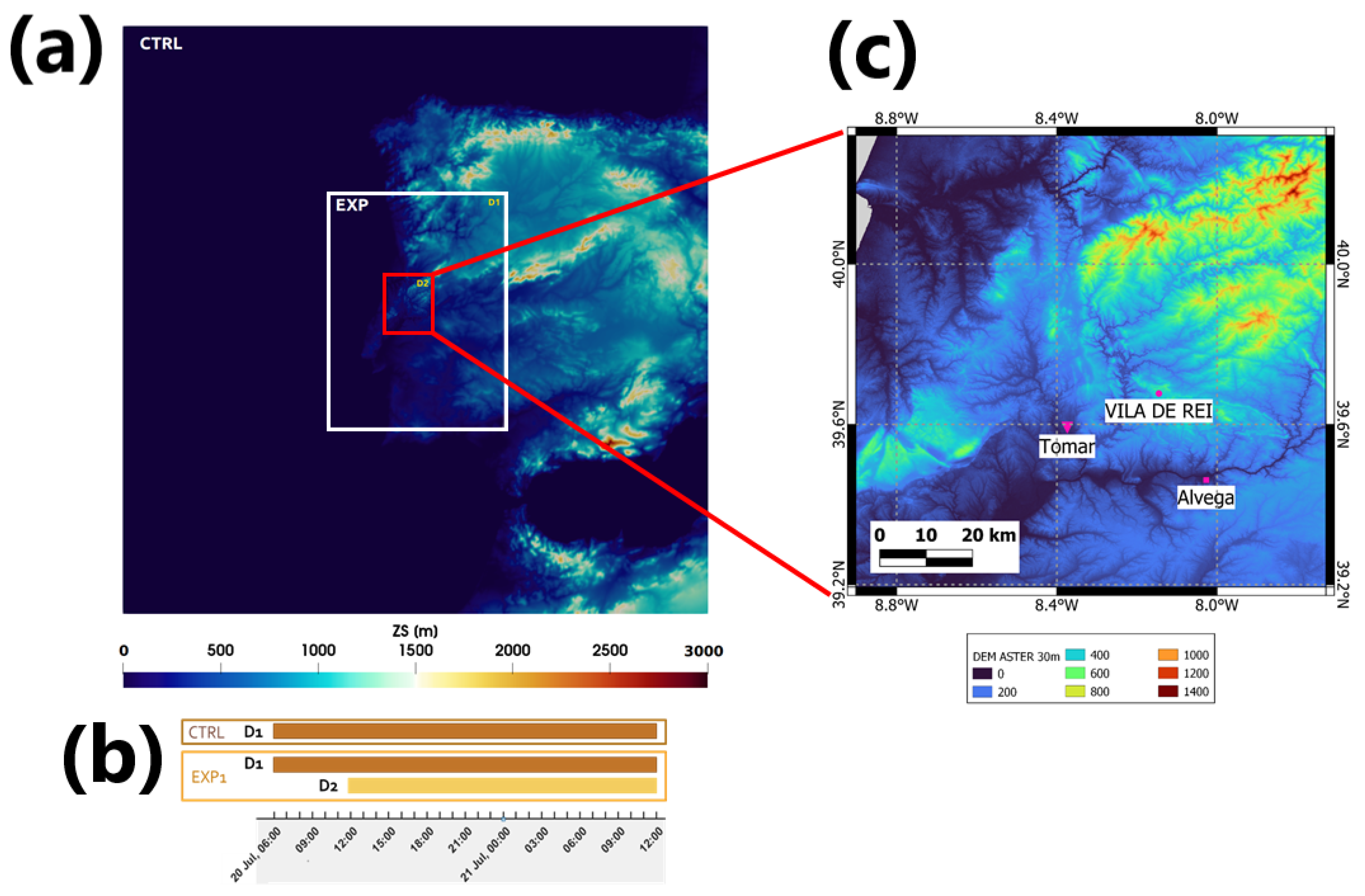
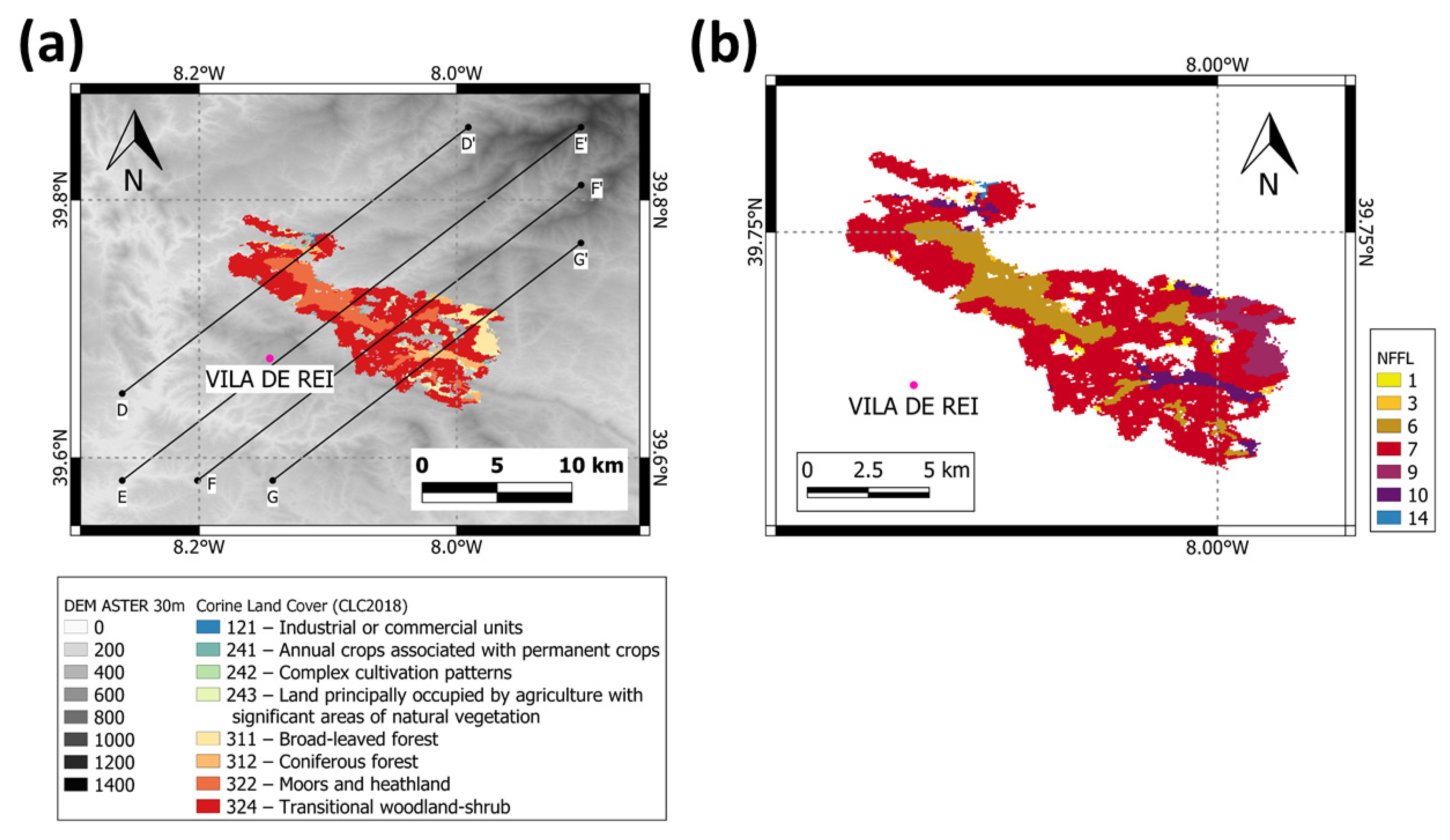

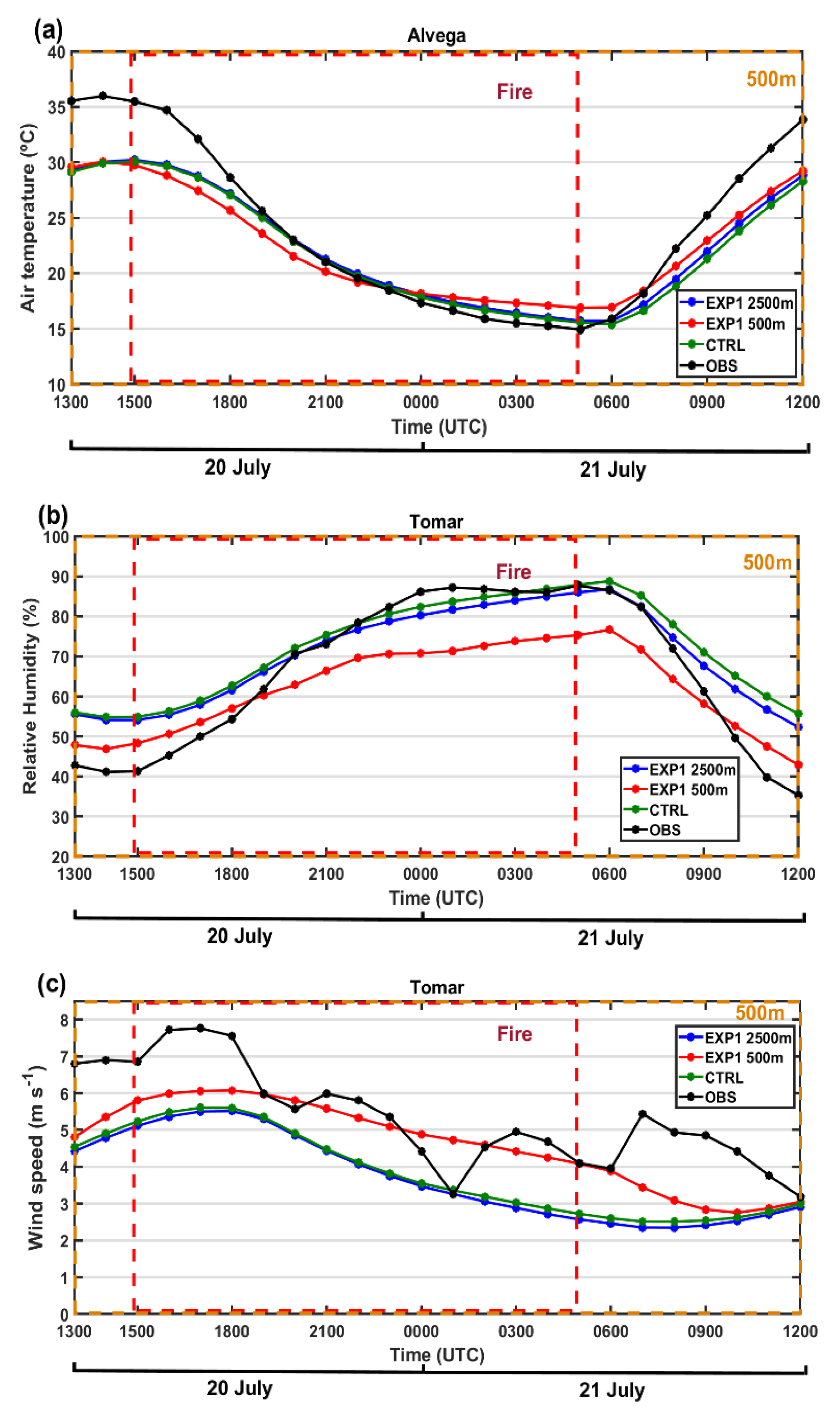
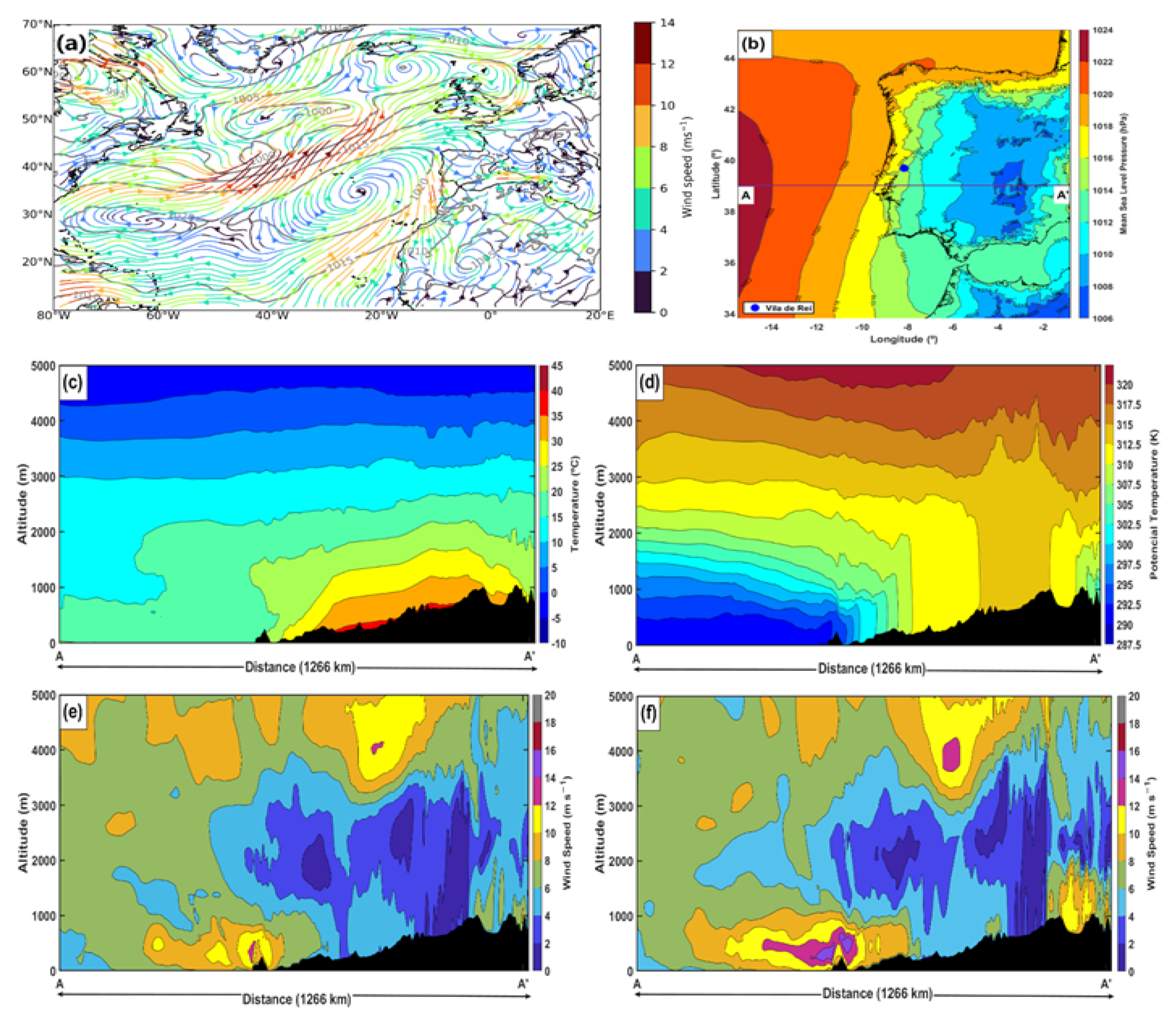

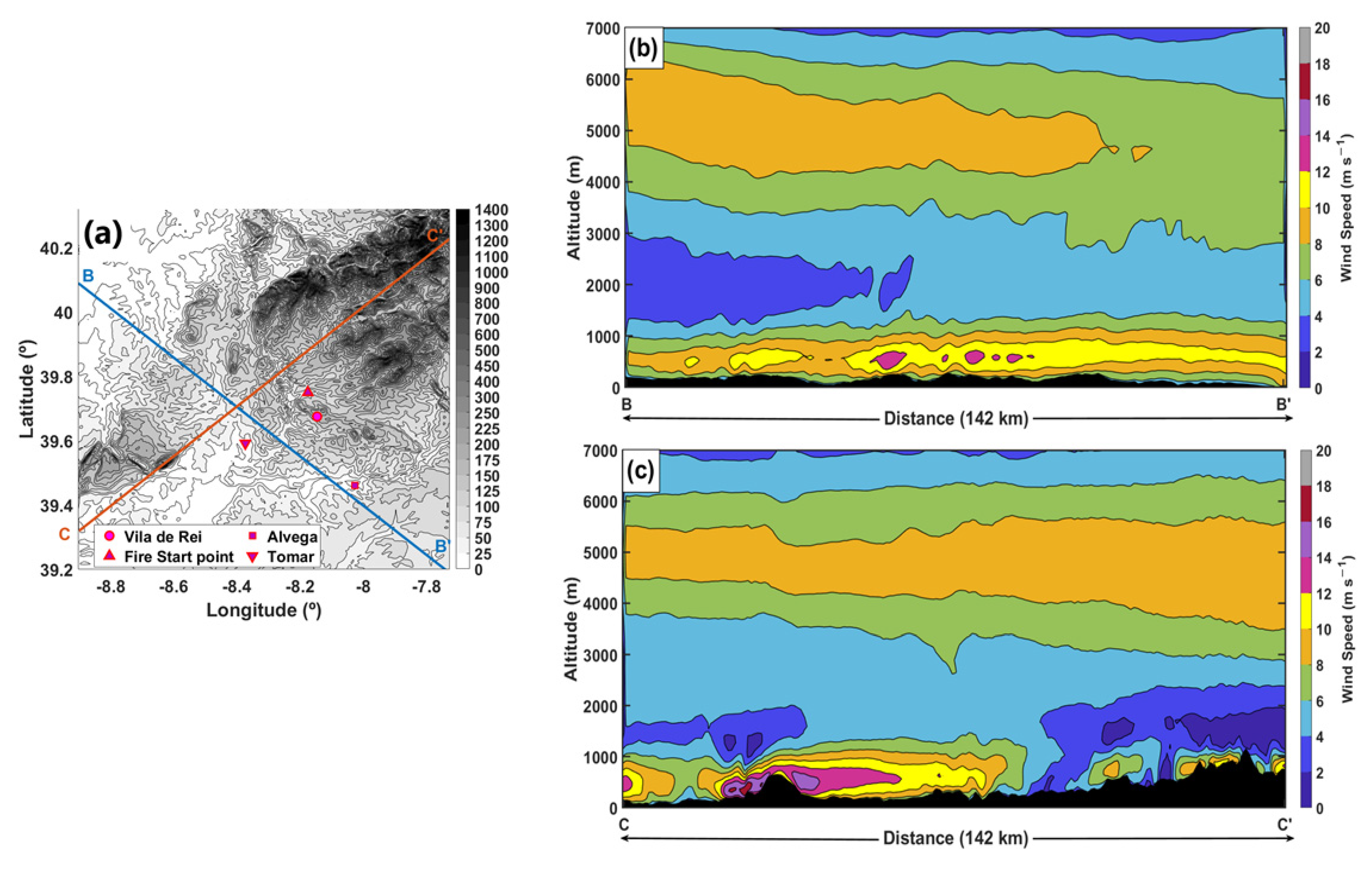
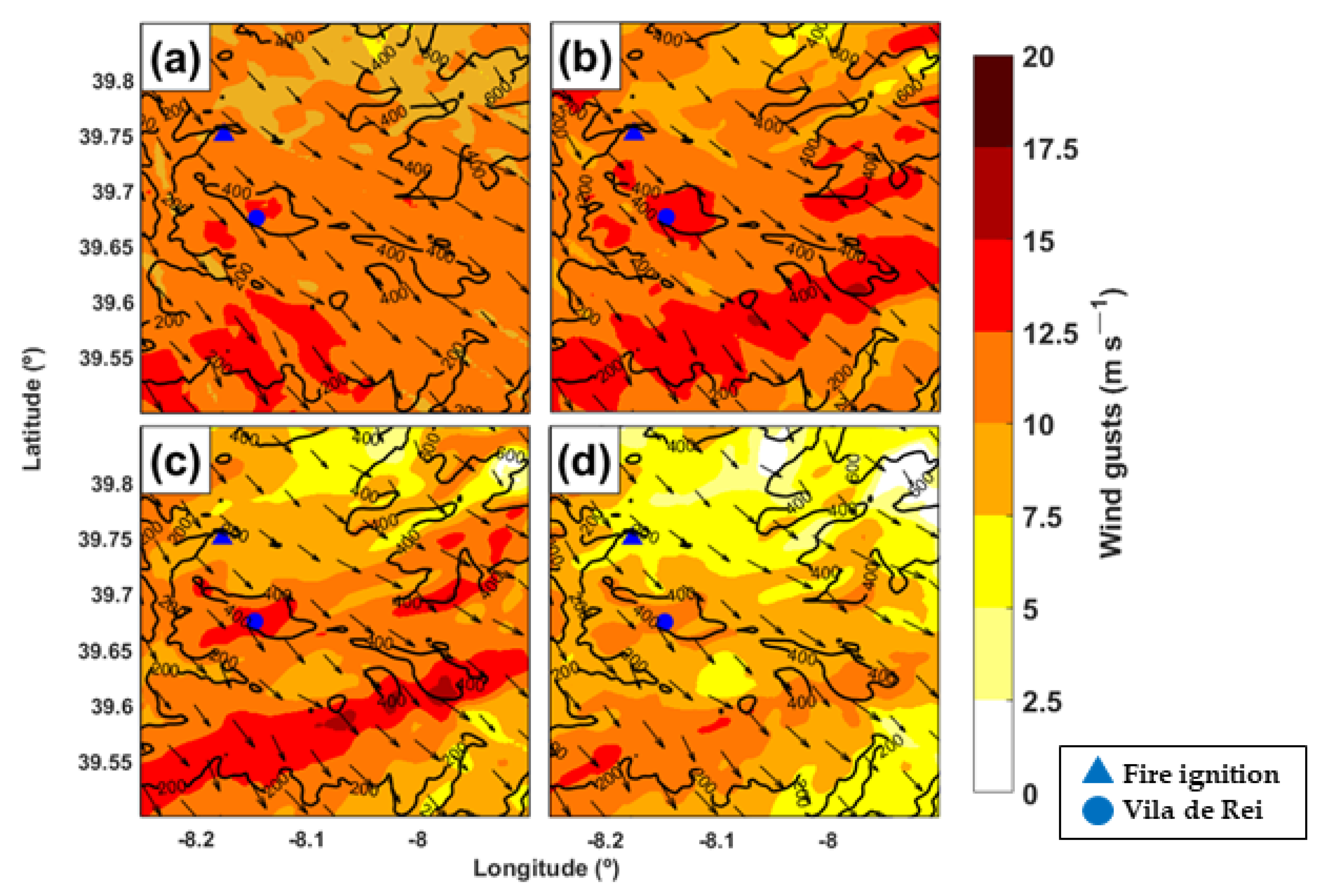

| CTRL | EXP | ||
|---|---|---|---|
| Parametrization | 2500 m | 2500 m | 500 m |
| Turbulence | 1D | 1D | 3D |
| Convection | None | None | None |
| Shallow convection | EDKF | EDKF | None |
| Cloud microphysics | ICE3 | ICE3 | ICE3 |
| Radiation | ECMWF | ECMWF | ECMWF |
| CLC Code | NFFL Fuel Model | Description |
|---|---|---|
| 121 | 14 | No fuel |
| 241 | 3 | Tall grass (76 cm) |
| 242 | 1 | Short grasses (30 cm) |
| 243 | 7 | Southern rough |
| 311 | 9 | Hardwood litter |
| 312 | 10 | Timber (litter and understory) |
| 322 | 6 | Dormant brush, hardwood slash |
| 324 | 7 | Southern rough |
Publisher’s Note: MDPI stays neutral with regard to jurisdictional claims in published maps and institutional affiliations. |
© 2022 by the authors. Licensee MDPI, Basel, Switzerland. This article is an open access article distributed under the terms and conditions of the Creative Commons Attribution (CC BY) license (https://creativecommons.org/licenses/by/4.0/).
Share and Cite
Purificação, C.; Andrade, N.; Potes, M.; Salgueiro, V.; Couto, F.T.; Salgado, R. Modelling the Atmospheric Environment Associated with a Wind-Driven Fire Event in Portugal. Atmosphere 2022, 13, 1124. https://doi.org/10.3390/atmos13071124
Purificação C, Andrade N, Potes M, Salgueiro V, Couto FT, Salgado R. Modelling the Atmospheric Environment Associated with a Wind-Driven Fire Event in Portugal. Atmosphere. 2022; 13(7):1124. https://doi.org/10.3390/atmos13071124
Chicago/Turabian StylePurificação, Carolina, Nuno Andrade, Miguel Potes, Vanda Salgueiro, Flavio T. Couto, and Rui Salgado. 2022. "Modelling the Atmospheric Environment Associated with a Wind-Driven Fire Event in Portugal" Atmosphere 13, no. 7: 1124. https://doi.org/10.3390/atmos13071124
APA StylePurificação, C., Andrade, N., Potes, M., Salgueiro, V., Couto, F. T., & Salgado, R. (2022). Modelling the Atmospheric Environment Associated with a Wind-Driven Fire Event in Portugal. Atmosphere, 13(7), 1124. https://doi.org/10.3390/atmos13071124










